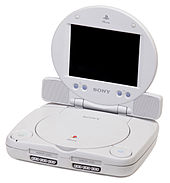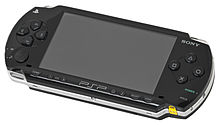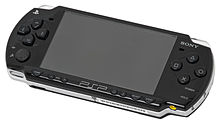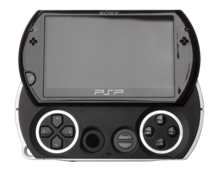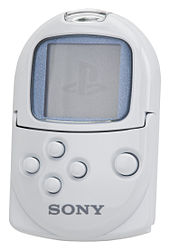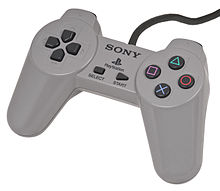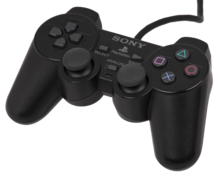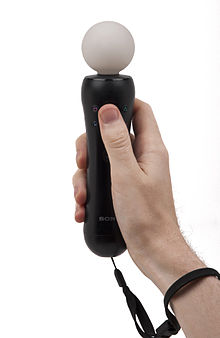
PlayStation
About this schools Wikipedia selection
SOS Children has tried to make Wikipedia content more accessible by this schools selection. Sponsor a child to make a real difference.
 |
|
|---|---|
| Product type | Video game console Handheld game console |
| Owner | Sony Computer Entertainment |
| Country | Minami-Aoyama, Minato, Tokyo, Japan |
| Introduced | 1994 |
| Markets | Worldwide |
| Registered as a trademark in | Worldwide |
The PlayStation ( Japanese: プレイステーション Hepburn: Pureisutēshon, officially abbreviated PS) is a series of video game consoles created and developed by Sony Computer Entertainment with consoles in the fifth to eighth generations. The brand was first introduced on December 3, 1994 in Japan with the launch of the original PlayStation console. It now consists of a total of three core home consoles, as well as a media centre, an online service, a line of controllers, two handhelds and a phone, as well as multiple magazines.
The first console in the series, the PlayStation, was the first video game console to ship 100 million units, 9 years and 6 months after its initial launch. Its successor, the PlayStation 2, was released in 2000. It is the best-selling home console to date, having reached over 150 million units sold as of January 31, 2011. Sony's latest console, the PlayStation 3, was released in 2006 has sold over 70 million consoles worldwide as of November 4, 2012 ( IDC January 2013 estimate: "about 77 million").
The first handheld game console in the PlayStation series, the PlayStation Portable or PSP, has sold a total of 71.4 million units worldwide as of September 14, 2011. Its successor, the PlayStation Vita, which launched in Japan on December 17, 2011 and in most other major territories in February 2012 has sold in excess of 1.2 million units as of the end of February 2012. Other hardware released as part of the PlayStation series includes the PSX, a digital video recorder which was integrated with the PlayStation and PlayStation 2, though it was short lived due to its high price and was never released outside Japan, as well as a Sony Bravia television set which has an integrated PlayStation 2. The main series of controllers utilized by the PlayStation series is the DualShock, which is a line of vibration-feedback gamepad having sold 28 million controllers as of June 28, 2008.
The PlayStation Network is an online service with over 69 million users worldwide (as of January 25, 2011). It comprises an online virtual market, the PlayStation Store, which allows the purchase and download of games and various forms of multimedia, a subscription-based online service known as PlayStation Plus and a social gaming networking service called PlayStation Home, which has over 14 million users worldwide. PlayStation Suite is an upcoming software framework that is aimed to provide PlayStation content cross-platform and cross-devices; currently only Android and the PlayStation Vita devices are supported. Content set to be released under the framework consist of only original PlayStation games currently.
Current-generation PlayStation products also use the XrossMediaBar, which is an award-winning graphical user interface. A new touchscreen-based user interface called LiveArea was launched for the PlayStation Vita, which integrates social networking elements into the interface. Additionally, PlayStation 2 and original PlayStation 3 consoles also featured support for Linux-based operating systems, though this has since been discontinued. The series has also been known for its numerous marketing campaigns, the latest of which being the " Long Live Play" commercials in the United States.
The series also has a strong lineup of first-party titles due to Sony Computer Entertainment Worldwide Studios, a group of fifteen first-party developers owned by Sony Computer Entertainment which are dedicated to developing first-party games for the series. In addition, the series features various budget re-releases of titles by Sony with different names for each region; these include the Greatest Hits, Platinum and The Best ranges of titles.
History
Origins
PlayStation was the brainchild of Ken Kutaragi, a Sony executive who had just come out of his hardware engineering division at that time and would later be dubbed as "The Father of the PlayStation".
The console's origins date back to 1988 where it was originally a joint project between Nintendo and Sony to create a CD-ROM for the Super Famicom .
The PlayStation made its debut at the Consumer Electronics Show in June 1991 when Sony revealed its console, a Super Famicom with a built-in CD-ROM drive (that incorporated Green Book technology or CDi). However, a day after the announcement at CES, Nintendo announced that it would be breaking its partnership with Sony, opting to go with Philips instead but using the same technology.
The deal was broken by Nintendo after they were unable to come to an agreement on how revenue would be split between the two companies.
The breaking of the partnership infuriated Sony President Norio Ohga, who responded by appointing Kutaragi with the responsibility of developing of the PlayStation project to rival Nintendo.
At that time, negotiations were still on-going between Nintendo and Sony, with Nintendo offering Sony a "non-gaming role" regarding their new partnership with Philips. This proposal was swiftly rejected by Kutaragi who was facing increasing criticism over his work with regard to entering the video game industry from within Sony. Negotiations officially ended in May 1992 and in order to decide the fate of the PlayStation project, a meeting was held in June 1992, consisting of Sony President Ohga, PlayStation Head Kutaragi and several senior members of Sony's board. At the meeting, Kutaragi unveiled a proprietary CD-ROM-based system he had been working on which involved playing video games with 3D graphics to the board. Eventually, Sony President Ohga decided to retain the project after being reminded by Kutaragi of the humiliation he suffered from Nintendo. Nevertheless, due to strong opposition from a majority present at the meeting as well as widespread internal opposition to the project by the older generation of Sony executives, Kutaragi and his team had to be shifted from Sony's headquarters to Sony Music, a completely separate financial entity owned by Sony, so as to retain the project and maintain relationships with Philips for the MMCD development project (which helped lead to the creation of the DVD).
Formation of Sony Computer Entertainment
At Sony Music, Kutaragi worked closely with Shigeo Maruyama, the CEO of Sony Music, and with Akira Sato to form Sony Computer Entertainment, Inc. (SCEI) on November 16, 1993. A building block of SCEI was its initial partnership with Sony Music which helped SCEI attract creative talent to the company as well as assist SCEI in manufacturing, marketing and producing discs, something that Sony Music had been doing with Music Discs. The final two key members of SCEI were Terry Tokunaka, the President of SCEI from Sony's headquarters, and Olaf Olafsson. Olafsson was CEO and president of New York based Sony Interactive Entertainment which was the mother company for the 1994-founded Sony Computer Entertainment of America (SCEA).
The PlayStation project, SCEI's first official project, was finally given the green light by Sony executives in 1993 after a few years of development. Also in 1993, Phil Harrison, who would later become President of Sony Computer Entertainment Worldwide Studios, was recruited into SCEI to attract developers and publishers to produce games for their new PlayStation platform.
After a demonstration of Sony's distribution plan as well as tech demos of its new console to game publishers and developers in a hotel in Tokyo in 1994, numerous developers began to approach PlayStation. Two of whom later became major partners were Electronic Arts in the West and Namco in Japan. One of the factors which attracted developers to the platform was the use of a 3D-capable, CD-ROM-based console which was much cheaper and easier to manufacture for in comparison to rival consoles from Sega and Nintendo which used cartridge systems. The project eventually hit Japanese stores in October 1994 and gained massive sales due to its lower price point than its competitor, the Sega Saturn. Popularity of the console spread after its release worldwide in North America and Europe.
Consoles
PlayStation
The original PlayStation released in December 1994 was the first of the ubiquitous PlayStation series of console and hand-held game devices. It has included successor consoles and upgrades including the Net Yaroze (a special black PlayStation with tools and instructions to program PlayStation games and applications), " PSone" (a smaller version of the original) and the PocketStation (a handheld which enhances PlayStation games and also acts as a memory card). It was part of the fifth generation of video game consoles competing against the Sega Saturn and the Nintendo 64. By March 31, 2005, the PlayStation and PSone had shipped a combined total of 102.49 million units, becoming the first video game console to sell 100 million units.
PSone
Released on July 7, 2000, concurrently with its successor the PlayStation 2, the PSone was a considerably smaller, redesigned version of the original PlayStation video game console. The PSone went on to outsell all-other consoles, including its successor, throughout the remainder of the year. It featured two main changes from its predecessor, the first being a cosmetic change to the console and the second being the home menu's Graphical User Interface.
PlayStation 2
Released in 2000, 15 months after the Dreamcast and a year before its other competitors, the Xbox and the Nintendo GameCube, the PlayStation 2 is part of the sixth generation of video game consoles, and is backwards-compatible with most original PlayStation games. Like its predecessor, it has received a slimmer redesign, and was also released built into the PSX DVR and the Sony BRAVIA KDL22PX300 HDTV. It is the most successful home console in the world, having sold over 150 million units as of January 31, 2011. On November 29, 2005, the PS2 became the fastest game console to reach 100 million units shipped, accomplishing the feat within 5 years and 9 months from its launch. This achievement occurred faster than its predecessor, the PlayStation, which took "9 years and 6 months since launch" to reach the same figure. PlayStation 2 shipments in Japan ended on December 28, 2012. The Guardian reported on January 4, 2013 that PS2 production had ended worldwide.
Slimline Model
Released in 2004, four years after the launch of the original PlayStation 2, the PlayStation 2 Slimline was the first major redesign of the PlayStation 2. Compared to its predecessor, the Slimline was smaller, thinner, quieter and also included a built-in Ethernet port (in some markets it also has an integrated modem). In 2007, Sony began shipping a revision of the Slimline which was lighter than the original Slimline together with a lighter AC adapter. In 2008, Sony released yet another revision of the Slimline which had an overhauled internal design incorporating the power supply into the console itself like the original PlayStation 2 resulting in a further reduced total weight of the console.
PlayStation 3
Released on November 11, 2006, the PlayStation 3 is a seventh generation game console from Sony. It competes with the Microsoft Xbox 360 and the Nintendo Wii. The PS3 is the first console in the series to introduce the use of motion-sensing technology through its Sixaxis wireless controller. The console also incorporates a Blu-ray Disc player and features high-definition resolution. The PS3 was originally offered with either a 20 GB or 60 GB hard drive, but over the years its capacity increased in increments available up to 500 GB. Like its predecessors, the PlayStation 3 was later released as a "slim" model. According to Sony Computer Entertainment, the PlayStation 3 has sold 70 million units worldwide as of November 4, 2012 ( IDC January 2013 estimate: "about 77 million").
Slim Model
Released in 2009, the redesigned model of the PlayStation 3 is the only model in production. The redesigned model is 33% smaller, 36% lighter, and consumes 34% to 45% less power than previous models. In addition, it features a redesigned cooling system and a smaller Cell processor which was moved to a 45nm manufacturing process. It sold in excess of a million units within its first 3 weeks on sale. The redesign also features support for CEC (more commonly referred to by its manufacturer brandings of BraviaSync, VIERA Link, EasyLink and others) which allows control of the console over HDMI by using the remote control as the controller. The PS3 slim also runs quieter and is cooler than previous models due to its 45 nm Cell. The PS3 Slim no longer has the "main power" switch (similar to PlayStation 2 slim), like the previous PS3 models, which was located at the back of the console. It was officially released on September 1, 2009 in North America and Europe and on September 3, 2009 in Japan, Australia and New Zealand.
Super Slim
In 2012, Sony revealed a new "Super Slim" PlayStation 3. The new console, with a completely redesigned case which has a sliding door covering the disc drive (which has been moved to the top of the console), is 4.3 pounds, almost three pounds lighter than the previous "slim" model. The console comes with either a 250-gigabyte or a 500-gigabyte hard drive. Several bundles which include a Super Slim PS3 and a selection of games are available.
PlayStation 4
The PlayStation 4 (PS4) is an upcoming video game console from Sony Computer Entertainment announced at a press conference on February 20, 2013. In the meeting, Sony revealed some hardware specifications of the new console. The eighth-generation system will introduce the x86 architecture to the PlayStation series and is expected to launch in the fourth quarter of 2013. According to lead system architect, Mark Cerny, development on the PlayStation 4 began as early as 2008. PlayStation Europe CEO Jim Ryan emphasized in 2011 that Sony wanted to avoid launching the next-generation console behind the competition.
Among the new applications and services, Sony will introduce the PlayStation App, allowing PS4 owners to turn smartphones and tablets into a second screen to enhance gameplay. The company also plans to debut Gaikai, a cloud-based gaming service that hosts downloadable content and games. By incorporating a share button on the new controller and making it possible to view in-game content being streamed live from friends, Sony plans to place more focus on social gameplay as well.
Comparison
| PlayStation | PlayStation 2 | PlayStation 3 | |
|---|---|---|---|
| Logo | 
|
 |
 |
| Console | 
|
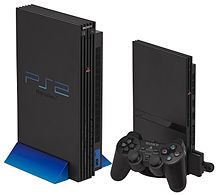 |
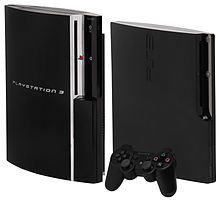 |
| Console Launch price | ¥39,800 US$299 £299 |
¥39,800 US$299 £299 |
¥49,980 (20 GB) US$499 (20 GB), US$599 (60 GB) £425 (60 GB) €599 (60 GB) |
| Release date |
PSone Model July 7, 2000 |
Slimline Model
|
Slim Model
Super Slim Model
|
| Units sold | 102.49 million shipped, including 28.15 million PSone units (as of March 31, 2007) | 154.4 million (as of November 21, 2011) | 70 million (as of November 4, 2012) ( IDC January 2013 estimate: "about 77 million") |
| Best-selling game | Gran Turismo; 10.85 million shipped (as of April 30, 2008) | Grand Theft Auto: San Andreas; 17.33 million shipped (as of March 26, 2008) | Call of Duty: Modern Warfare 3; 12.16 million shipped (as of July 26, 2012) |
| Media | CD-ROM-based media | DVD-ROM/CD-ROM | BD-ROM, DVD-ROM, CD-ROM, SACD (1st and 2nd Gen Only) |
| Included accessories and extras |
|
|
|
| Accessories (retail) |
|
|
|
| CPU | R3000A 32bit RISC chip @ 33.8mhz - Manufactured by LSI Corporation | 300 MHz MIPS " Emotion Engine" | Cell Broadband Engine (3.2 GHz Power Architecture-based PPE with eight 3.2 GHz SPE) |
| GPU | 16.7 million colors Resolution: 256x224 - 640x480 Sprite/BG drawing Adjustable frame buffer No line restriction Unlimited CLUTs (Colour Look-Up Tables) 4,000 8x8 pixel sprites with individual scaling and rotation Simultaneous backgrounds (Parallax scrolling) 360,000 polygons/sec |
147 MHz "Graphics Synthesizer"; fill rate 2.352 gigapixel/sec; 1.1 gigapixel w. 1 texture(diffuse); 588 megapixel/sec w. 2 textures (2 diffuse maps or 1 diffuse map and 1 other(0 around 74 mill, 1 around 40 mill, 2 around 20 mill); 2 textures per pass Capable of multi-pass rendering; Connected to VU1 on CPU (a vector only for visual style coding things with 3.2Gflops) to deliver enhanced shader graphics and other enhanced graphics |
550 MHz RSX "Reality Synthesizer" (based on Nvidia G70 architecture) |
| Online service | None | Non-unified service | PlayStation Network PlayStation Store Internet browser A/V chat via PlayStation Eye or PS2 EyeToy, voice chat via headset PlayStation Home |
| Backward compatibility | N/A | PlayStation | 20GB & 60GB: All PlayStation and PlayStation 2 titles Original 80GB: All PS1 titles, most PS2 titles. |
| System software | proprietary OS | proprietary OS, Linux DVD Playback Kit |
XrossMediaBar (XMB) |
| System software features |
Audio CD playback |
Audio CD playback DVD Playback |
Operating Systems can be installed and run via a hypervisor (feature unavailable with Slim Model) Audio CD playback |
| Consumer programmability | Requires the Net Yaroze kit | Yabasic software, Linux for PlayStation 2 | Development on console via free Linux platform or PC. |
Handheld systems
PlayStation Portable
Released in March 2005, the PlayStation Portable (PSP) was Sony's first handheld console to compete with Nintendo's DS console. The console is the first to utilize a new proprietary optical storage medium known as Universal Media Disc (UMD), which can store both games and movies. It contains 32 MB of internal flash memory storage, expandable via Memory Stick PRO Duo cards. It has a similar control layout to the PS3 with its PlayStation logo button and its ![]() ('Triangle'),
('Triangle'), ![]() ('Circle/O'),
('Circle/O'), ![]() ('Cross/X') and
('Cross/X') and ![]() ('Square') buttons in their white-colored forms.
('Square') buttons in their white-colored forms.
2000 and 3000 models
Released in September 2007, the PSP Slim & Lite (also known as the PSP-2000) was the first major hardware revision of the PlayStation Portable. The Slim & Lite was 33% lighter and 19% slimmer than the original PlayStation Portable. The capacity of the battery was also reduced by ⅓ but the run time remained the same as the previous model due to lower power consumption. Older model batteries will still work and they extend the amount of playing time. The PSP Slim & Lite has a new gloss finish. Its serial port was also modified in order to accommodate a new video-out feature (while rendering older PSP remote controls incompatible). On a PSP-2000, PSP games will only output to external monitors or TVs in progressive scan mode, so that televisions incapable of supporting progressive scan will not display PSP games; non-game video will output in either progressive or interlaced mode. USB charging was also made possible. Buttons are also reportedly more responsive on the Slim and Lite. In 2008, Sony released a second hardware revision called the PSP-3000 which included several features that were not present in the Slim & Lite, such as a built-in microphone and upgraded screen, as well as the ability to output PSP games in interlaced mode.
PSP Go model
Released in October 2009, the PSP Go is the biggest redesign of the PlayStation Portable to date. Unlike previous PSP models, the PSP Go does not feature a UMD drive but instead has 16 GB of internal flash memory to store games, videos and other media. This can be extended by up to 32GB with the use of a Memory Stick Micro (M2) flash card. Also unlike previous PSP models, the PSP Go's rechargeable battery is not removable or replaceable by the user. The unit is 43% lighter and 56% smaller than the original PSP-1000, and 16% lighter and 35% smaller than the PSP-3000. It has a 3.8" 480 × 272 LCD (compared to the larger 4.3" 480 × 272 pixel LCD on previous PSP models). The screen slides up to reveal the main controls. The overall shape and sliding mechanism are similar to that of Sony's mylo COM-2 internet device. The PSP Go is being produced and sold concurrently with its predecessor the PSP-3000 although it will not replace it. All games on the PSP Go must be purchased and downloaded from the PlayStation Store as the handheld is not compatible with the original PSP's physical media, the Universal Media Disc. The handheld also features connectivity with the PlayStation 3's controllers the Sixaxis and DualShock 3 via Bluetooth connection.
E1000 model
The PSP-E1000 is a budget-focused PSP model which, unlike previous PSP models, does not feature Wi-Fi or stereo speakers (replaced by a single mono speaker) and has a matte "charcoal black" finish similar to the slim PlayStation 3. The E1000 was announced at Gamescom 2011 and available across the PAL region for an RRP of €99.99.
PlayStation Vita
Released in December 2011, the PlayStation Vita was previously codenamed Next Generation Portable (NGP). It features a 5 inch OLED touchscreen, two analog sticks, a rear touchpad, Sixaxis motion sensing and a 4 core ARM Cortex-A9 MPCore processor. The PlayStation Vita was officially unveiled by Sony on January 27, 2011 at the PlayStation Meeting 2011.
Other hardware
PSX (2003)
Released solely in Japan in 2003, the Sony PSX was a fully integrated DVR and PlayStation 2 video game console. It was the first Sony product to utilize the XrossMediaBar (XMB) and can be linked with a PlayStation Portable to transfer videos and music via USB. It also features software for video, photo and audio editing. PSX supports online game compatibility using an internal broadband adapter. Games that utilize the PS2 HDD (for example, Final Fantasy XI) are supported as well. It was the first product released by Sony under the PlayStation brand that did not include a controller with the device itself.
PocketStation
The PocketStation was a miniature game console created by SCE as a peripheral for the original PlayStation. Released exclusively in Japan on December 23, 1999, it featured a monochrome LCD display, a speaker, a real-time clock and infrared communication capability. It could also be used as a standard PlayStation memory card by connecting it to a PlayStation memory card slot. It was extremely popular in Japan and Sony originally had plans to release it in the United States but the plan was ultimately scrapped due to various manufacturing and supply-and-demand problems.
Television sets
Released in 2010, the Sony BRAVIA KDL22PX300 is a 22 inch 720p television which incorporates a PlayStation 2 console, along with 4 HDMI ports.
A 24 inch 1080p PlayStation branded 3D television, officially called the PlayStation 3D Display, was released in late 2011. A feature of this 3D television is SimulView. During multiplayer games, each player will only see their respective screen (in full HD) appear on the television through their respective 3D glasses, instead of seeing a split screen (e.g. player 1 will only see player 1's screen displayed through their 3D glasses).
Sony Ericsson Xperia Play
The Xperia Play is an Android-powered smartphone with a slide-up gamepad resembling the PSP Go developed by Sony Ericsson aimed at gamers, and is the first to be PlayStation Certified. Also can download PlayStation Suite App.
Sony Tablet S and P
These are PlayStation Certified Android tablets, released in 2011 and 2012. They offer connectivity with PlayStation 3 controllers, and integrate with the PlayStation network using a proprietary application.
Games
Each console has a variety of games. Most games released on the original PlayStation are backwards compatible and can be played directly on its successors, the PlayStation 2, PSX and PlayStation 3. Some of these games can also be played on the PlayStation Portable but they must be purchased and downloaded from a list of PSone Classics from the PlayStation Store. Games released on the PlayStation 2 can currently only be played on the original console as well as the PSX and the early models of the PlayStation 3 which are backwards compatible. The PlayStation 3 has two types of games, those released on Blu-ray Discs and downloadable games from the PlayStation Store. The PlayStation Portable consists of numerous games available on both its physical media, the Universal Media Disc and the Digital Download from the PlayStation Store. However, some games are only available on the UMD while others are only available on the PlayStation Store. The Next Generation Portable will consist of games available on both its physical media, the NVG Card and Digital Download from the PlayStation Store.
First party games
Sony Computer Entertainment Worldwide Studios is a group of video game developers owned by Sony Computer Entertainment. It is dedicated to developing video games exclusively for the PlayStation series of consoles. The series has produced several best-selling franchises such as the Gran Turismo series of racing video games as well as critically acclaimed titles such as the Uncharted Series. Other notable franchises include Ape Escape, God of War, Twisted Metal and more recently, LittleBigPlanet and MotorStorm.
Re-releases
Greatest Hits (North America), Platinum Range (PAL territories) and The Best (Japan and Asia) are video games for the Sony PlayStation, PlayStation 2, PlayStation 3, and PlayStation Portable consoles that have been officially re-released at a lower price by Sony. Each region has its own qualifications to enter the re-release program. Initially, during the PlayStation era, a game had to sell at least 150,000 copies (later 250,000) and be on the market for at least a year to enter the Greatest Hits range. During the PlayStation 2 era, the requirements increased with the minimum number of copies sold increasing to 400,000 and the game had to be on the market for at least 9 months. For the PlayStation Portable, games had to be on the market for at least 9 months with 250,000 copies or more sold. Currently, a PlayStation 3 game must be on the market for 10 months and sell at least 500,000 copies to meet the Greatest Hits criteria. PSone Classics were games that were released originally on the PlayStation and have been re-released on the PlayStation Store for the PlayStation 3 and PlayStation Portable. Classics HD are compilations of PlayStation 2 games that have been remastered for the PlayStation 3 on a single disc with additional features such as upscaled graphics, PlayStation Move support, 3D support and PlayStation Network trophies. PlayStation Mobile (formerly PlayStation Suite) is a cross-platform, cross-device software framework aimed at providing PlayStation content, currently original PlayStation games, across several devices including PlayStation Certified Android devices as well as the PlayStation Vita.
Online Services
Online gaming on the PlayStations first started in July 2001 with the release of PlayStation 2's unnamed online service in Japan. Later in August 2002 saw its release in North America, followed by the European release in June 2003. The service is still active and continues to be played by gamers.
Released in 2006, the PlayStation Network is an online service focusing on online multiplayer gaming and digital media delivery. The service is provided and run by Sony Computer Entertainment for use with the PlayStation 3 and PlayStation Portable video game consoles. The service currently has over 50 million users worldwide. The Sony Entertainment Network provides other features for users like PlayStation Home, PlayStation Store, and Trophies.
PlayStation Store
The PlayStation Store is an online virtual market available to users of the PlayStation 3 and PlayStation Portable game consoles via the PlayStation Network. The store uses both physical currency and PlayStation Network Cards. The PlayStation Store's gaming content is updated every Tuesday and offers a range of downloadable content both for purchase and available free of charge. Available content includes full games, add-on content, playable demos, themes and game and movie trailers. The service is accessible through an icon on the XMB on the PS3 and PSP. The PS3 store can also be accessed on the PSP via a Remote Play connection to the PS3. The PSP store is also available via the PC application, Media Go. As of September 24, 2009, there have been over 600 million downloads from the PlayStation Store worldwide.
Video content such as films and television shows are also available from the PlayStation Store on the PlayStation 3 and PSP and will be made available on some new Sony BRAVIA televisions, VAIO laptop computers and Sony Blu-ray Disc players from February 2010.
Life with PlayStation
Life with PlayStation was a Folding@home application available for PlayStation 3 which connected to Stanford University’s Folding@home distributed computer network and allowed the user to donate their console's spare processing cycles to the project. Folding@home is supported by Stanford University and volunteers make a contribution to society by donating computing power to this project. Research made by the project may eventually contribute to the creation of vital cures. The Folding@home client was developed by Sony Computer Entertainment in collaboration with Stanford University. Life with PlayStation also consisted of a 3D virtual view of the Earth and contained current weather and news information of various cities and countries from around the world, as well as a World Heritage channel which offered information about historical sites, and the United Village channel which is a project designed to share information about communities and cultures worldwide. As of PlayStation 3 system software update version 4.30 on October 24, 2012, the Life With PlayStation project has ended.
PlayStation Plus
PlayStation Plus, a subscription-based service on the PlayStation Network, compliments the standard PSN services. It enables an auto-download feature which allows the console to automatically download game patches and system software updates. Subscribers also gain early or exclusive access to some betas, game demos, premium downloadable content (such as full game trials of retail games like Infamous and LittleBigPlanet) and other PlayStation Store items, as well as a free subscription to Qore. Other downloadable items include PlayStation Store discounts and free PlayStation Network games, PSone Classics, PlayStation Minis, themes and avatars.
PlayStation Blog
PlayStation Blog is an online PlayStation focused gaming blog which is part of the PlayStation Network. It was launched on June 11, 2007 and since its launch, has featured in numerous interviews with third-party companies such as Square Enix. It also has posts from high-ranking Sony Computer Entertainment executives such as Jack Tretton, President and Chief Executive Officer of Sony Computer Entertainment. A sub-site of the blog called PlayStation Blog Share was launched on March 17, 2010 and allowed readers of the blog as well as users of the PlayStation Blog to submit ideas to the PlayStation team about anything PlayStation-related and vote on the ideas of other submissions.
PlayStation App
The PlayStation App is an application that was released on January 11, 2011 in several European countries for iOS (version 4 and above) and for Android (version 1.6 and above). It allows users to view their trophies, see which of their PSN friends are online and read up to date information about PlayStation. It does not feature any gaming functionality.
PlayStation Mobile
The PlayStation Mobile (formerly PlayStation Suite) is a software framework that will be used to provide downloadable PlayStation content to devices running Android 2.3 and above as well as the PlayStation Vita. The framework will be cross-platform and cross-device, which is what Sony calls "hardware-neutral". It is currently set to release before the end of calendar year 2011. In addition, Android devices that have been certified to be able to play back PlayStation Suite content smoothly will be certified with the PlayStation Certified certification.
Online social networking services
PlayStation Home
PlayStation Home is a community-based social gaming networking service for the PlayStation 3 on the PlayStation Network (PSN). It is available directly from the PlayStation 3 XrossMediaBar. Membership is free, and only requires a PSN account. Home has been in development since early 2005 and started an open public beta test on December 11, 2008. Home allows users to create a custom avatar, which can be made to suit the user's preference. Users can decorate their avatar's personal apartment ("HomeSpace") with default, bought, or won items. They can travel throughout the Home world (except cross region), which is constantly updated by Sony and partners. Each part of the world is known as a space. Public spaces can just be for display, fun, or for meeting people. Home features many mini-games which can be single player or multiplayer. Users can shop for new items to express themselves more through their avatars or HomeSpace. Home features video screens in many places for advertising, but the main video content is shown at the theatre for entertainment. Home plays host to a variety of special events which range from prize-giving events to entertaining events. Users can also use Home to connect with friends and customize content. Xi, a once notable feature of Home, is the world's first console based Alternate Reality Game that took place in secret areas in Home and was created by nDreams.
Room for PlayStation Portable
"Room" (officially spelled as R∞M with capital letters and the infinity symbol in place of the "oo") was being beta tested in Japan from October 2009 to April 2010. Development of Room has been halted on April 15, 2010 due to negative feedback from the community. Announced at TGS 2009, it was supposed to be a similar service to the PlayStation Home and was being developed for the PSP. Launching directly from the PlayStation Network section of the XMB was also to be enabled. Just like in Home, PSP owners would have been able to invite other PSP owners into their rooms to "enjoy real time communication." A closed beta test had begun in Q4 2009 in Japan.
Software
LiveArea
LiveArea, designed to be used on the PlayStation Vita, is a graphical user interface set to incorporate various social networking features via the PlayStation Network. It has been designed specifically as a touchscreen user interface for users.
Linux operating systems
Linux for PlayStation 2
In 2002, Sony released the first useful and fully functioning operating system for a video game console, after the Net Yaroze experiment for the original PlayStation. The kit, which included an internal hard disk drive and the necessary software tools, turned the PlayStation 2 into a full fledged computer system running Linux. Users can utilize a network adapter to connect the PlayStation 2 to the internet, a monitor cable adaptor to connect the PlayStation 2 to computer monitors as well as a USB Keyboard and Mouse which can be used to control Linux on the PlayStation 2.
Linux for PlayStation 3
The PlayStation 3 (excluding PlayStation 3 Slim) also supports running Linux OS on firmwares prior to 3.21 without the need for buying additional hardware purchase. Yellow Dog Linux provides an official distribution that can be downloaded, and other distributions such as Fedora, Gentoo and Ubuntu have been successfully installed and operated on the console. The use of Linux on the PlayStation 3 allowed users to access 6 of the 7 Synergistic Processing Elements; Sony implemented a hypervisor restricting access to the RSX. The feature to install a second operating system on a PlayStation 3 was removed in a recent firmware update.
Controllers
Early PlayStation controllers
Released in 1994, the PlayStation control pad was the first controller made for the original PlayStation. It featured a basic design of a D-pad, 4 main select buttons ( ![]() ('Green Triangle'),
('Green Triangle'), ![]() ('Red Circle/Red O'),
('Red Circle/Red O'), ![]() ('Blue Cross/Blue X') and
('Blue Cross/Blue X') and ![]() ('Pink Square') ), and start and select buttons on the face. 'Shoulder buttons' are also featured on the top [L1, L2, R1, R2] (named by the side [L=Left, R=Right] and 1 and 2 [top and bottom]). In 1996, Sony released the PlayStation Analog Joystick for use with flight simulation games. The original digital controller was then replaced by the Dual Analog in 1997, which added two analog sticks based on the same potentiometer technology as the Analog Joystick. This controller was then also succeeded by the DualShock controller.
('Pink Square') ), and start and select buttons on the face. 'Shoulder buttons' are also featured on the top [L1, L2, R1, R2] (named by the side [L=Left, R=Right] and 1 and 2 [top and bottom]). In 1996, Sony released the PlayStation Analog Joystick for use with flight simulation games. The original digital controller was then replaced by the Dual Analog in 1997, which added two analog sticks based on the same potentiometer technology as the Analog Joystick. This controller was then also succeeded by the DualShock controller.
DualShock series and Sixaxis
Released in 1998, the DualShock controller for the PlayStation succeeded its predecessor, the Dual Analog, and would go on to become the longest running series of controllers for the PlayStation brand. In addition to the inputs of the original, digital, controller (![]() ,
, ![]() ,
, ![]() ,
, ![]() , L1, L2, R1, R2, Start, Select and a D-pad), the DualShock featured two analog sticks in a similar fashion to the previous Dual Analog controller, which can also be depressed to activate the L3 and R3 buttons.
, L1, L2, R1, R2, Start, Select and a D-pad), the DualShock featured two analog sticks in a similar fashion to the previous Dual Analog controller, which can also be depressed to activate the L3 and R3 buttons.
The DualShock series consists of three controllers: the DualShock which was the fourth controller released for the PlayStation; the DualShock 2, the only standard controller released of the PlayStation 2, and the DualShock 3, the second and current controller released for the PlayStation 3. The Sixaxis was the first official controller for the PlayStation 3, and is based on the same design as the DualShock series (but lacking the vibration motors of the DualShock series of controllers).
Like the Dual Analog, the DualShock and DualShock 2 feature an "Analog" button between the analog sticks that toggles the analog sticks on and off (for use with games which support only the digital input of the original controller). On the PlayStation 3 Sixaxis and DualShock 3 controllers, the analog sticks are always enabled. Beginning with the Sixaxis, a 'PlayStation button' (which featured the incorporated PS logo and is similar in function to the Xbox 360 "Guide" button) was included on controllers. The PlayStation button replaces the "Analog" button of the DualShock and DualShock 2 controllers. Pressing the PS button on the PS3 brings up the XMB, while holding it down brings up system options (such as quit the game, change controller settings, turn off the system, and turn off the controller).
PlayStation Move
PlayStation Move is a motion-sensing game controller platform for the PlayStation 3 video game console by Sony Computer Entertainment (SCE). Based on the handheld motion controller wand, PlayStation Move uses the PlayStation Eye webcam to track the wand's position and the inertial sensors in the wand to detect its motion. First revealed on June 2, 2009, PlayStation Move was launced in Q3/Q4 2010. Hardware available at launch included the main PlayStation Move motion controller and an optional PlayStation Move sub-controller. Although PlayStation Move is implemented on the existing PlayStation 3 console, Sony states that it is treating Move's debut as its own major "platform launch," planning an aggressive marketing campaign to support it. In addition to selling the controllers individually, Sony also plans to provide several different bundle options for PlayStation Move hardware; including a starter kit with a PS Eye, a Move motion controller, and a demo/sampler disc, priced under US$100; a full console pack with a PS3 console, DualShock 3 gamepad, PS Eye, and Move motion controller; and bundles of a Move motion controller with select games.
Marketing
The PlayStation has been known for several advertising campaigns.
Slogans
Advertising slogans used for each PlayStation console iteration:
- PlayStation
- "Enos Lives" (The first letter 'E' was printed in red to denote the word, ready. Enos stood for Ready, Ninth of September)
- "U R Not E" (The letter 'E' was printed in red to denote the word, ready, as in You Are Not Ready)
- "Live In Your World. Play In Ours."
- "Do Not Underestimate The Power of PlayStation." (From the S.A.P.S. - Society Against PlayStation — series of adverts)
- PSone
- "Wherever, Whenever, Forever."
- PlayStation 2
- "The Beginning."
- "Live In Y
 ur W
ur W rld, Pl
rld, Pl y In
y In  urs." (The PlayStation face button icons were used to denote certain letters: Live In Your World, Play In Ours)
urs." (The PlayStation face button icons were used to denote certain letters: Live In Your World, Play In Ours) - "(Welcome to the) Third Place."
- "Fun, Anyone?"
- PlayStation Portable
- "PSP Hellz Yeah" (PSP-1000 Series)
- "Dude, Get Your Own..." (PSP-2000 Series)
- "Everywhere Just Got Better" (PSP-3000 Series and PSPgo)
- "It's GO Time" (PSPgo)
- "Your Whole World In Your Hands" (UK & Europe Territories)
- "Step Your Game Up" (US Territory, PSP-3000 Series and PSPgo)
- PlayStation 3
- "The Wait Is Over"
- "Welcome Chang3" (the number three is used to denote an 'e' and was printed in red)
- "This is Living."
- "Play B3yond" (the number three is used to denote an 'e' and was printed in red)
- "It Only Does Everything" (US Commercials)
- "The Game Is Just The Start. Start PS3." (UK and EU countries)
- "Long Live Play"
- "Never Stop Playing"
- PlayStation Move
- "This Changes Everything".
- "Move Into The Action"
- PlayStation Network
- "Download, Play, Connect."
- PlayStation Vita
- "Never Stop Playing."
- "The World is in Play." (EU only)
- PlayStation 4
- "See the Future"
- "Push the boundaries of Play"
Notable advertising campaigns
It Only Does Everything
The most notable of recent PlayStation commercials is the series of "It Only Does Everything" commercials featuring a fictional character called Kevin Butler who is a Vice President at PlayStation. These commercials usually advertise the PlayStation 3 and its games through a series of comedic answers to "Dear PlayStation" queries. These commercials garnered popularity among gamers, though its debut commercial received criticism from the Nigerian government due to a reference to the common 419 scams originating in Nigeria. Sony issued an apology and a new version of the advert with the offending line changed was produced.
A spin-off of the campaign has been created for the PlayStation Portable which features similar campaign commercials called the "Step Your Game Up" campaign featuring a fictional teenage character named Marcus Rivers acting in a similar fashion to Kevin Butler but answering the "Dear PlayStation" queries about the PSP.
Netherlands Ceramic White PSP Commercials
In July 2006, an advertising campaign in the Netherlands was released in which a Caucasian model dressed entirely in white and a black model dressed entirely in black was used to compare Sony's new Ceramic White PSP and the original Piano Black PSP. This series of ads depicted both models fighting with each other and drew criticism from the media for being racist, though Sony maintains that the ad did not feature any racist message.
All I want for Xmas is a PSP
In November 2006, a marketing company employed by Sony's American division created a website entitled "All I want for Xmas is a PSP", designed to promote the PSP virally. The site contained a blog which was purportedly written by "Charlie", a teenage boy attempting to get his friend Jeremy's parents to buy him a PSP, and providing a "music video" of either Charlie or Jeremy "rapping" about the PSP. Visitors to the website quickly recognized that the website was registered to a marketing company, exposing the campaign on sites such as YouTube and digg. Sony was forced to admit that the site was in fact a marketing campaign and in an interview with next-gen.biz, Sony admitted that the idea was "poorly executed".
Reception
In 2005, Australian newspaper The Age wrote an article about the PlayStation brand. Among the numerous interviews conducted with various people in the industry was an interview with Dr Jeffrey Brand, associate professor in communication and media at Bond University who said, "PlayStation re-ignited our imagination with video games". Game designers Yoshiki Okamoto called the brand "revolutionary — PlayStation has changed gaming, distribution, sales, image and more". while Evan Wells of Naughty Dog said "PlayStation is responsible for making playing games cool."
In 2009, ViTrue, Inc. listed the PlayStation brand as number 13 on their "The Vitrue 100: Top Social Brands of 2009". The ranking was based on various aspects mainly dealing with popular social media sites in aspects such as Social Networking, Video Sharing, Photo Sharing and Blogs.
In 2010, Gizmodo stated that the PlayStation brand was one of the last Sony products to completely stand apart from its competitors, stating that "If you ask the average person on the street what their favorite Sony product is, more often than not you'll hear PlayStation". As of April 2012, the PlayStation brand is the "most followed" brand on social networking site, Facebook, with over 22 million fans and followers in total which is more than any other brand in the entertainment industry. A study by Greenlight's Entertainment Retail has also shown that the PlayStation brand is the most interactive making 634 posts and tweets on social networking sites Facebook and Twitter.
